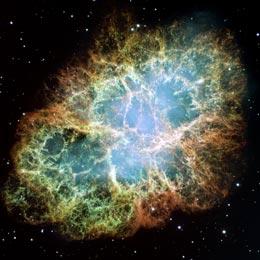looking for gravity waves? come to my house.
Gravity waves 'around the corner' : Nature News
Published online 19 August 2009 | Nature | doi:10.1038/news.2009.844
News
Gravity waves 'around the corner'
Sensitive search fails to find ripples in space, but boosts hopes for future hunts.
 Supernovas, such as the one which created the Crab Nebula, should send out bursts of gravity waves.NASA
Supernovas, such as the one which created the Crab Nebula, should send out bursts of gravity waves.NASAThe hunt for gravitational waves may not have found the elusive ripples in space-time predicted by Albert Einstein, but the latest results from the most sensitive survey to date are providing clear insight into the origins and fabric of the Universe.
General relativity predicts that gravitational waves are generated by accelerating masses. Violent yet rare events, such as a supernova explosion or the collision of two black holes, should make the biggest and most detectable waves.
A more pervasive yet weaker source of waves should be the stochastic gravitational wave background (SGWB) that was mostly created in the turmoil immediately after the Big Bang, and which has spread unhindered through the Universe ever since.
The Laser Interferometer Gravitational-wave Observatory (LIGO) detectors, based in Washington state and Louisiana, look for these cosmic gravitational waves by measuring any slight disturbance to laser beams that shuttle between heavy mirrors held kilometres apart. Whereas the gravitational wave signal from a distinct event, such as a black-hole merger, would appear as a spike in the LIGO data, the SGWB is a murmur that is more difficult to detect.
“For 40 years they've been saying that gravity waves are around the corner ... I think for the first time that's actually a true statement.”
Michael Turner
University of Chicago, Illinois
Working with the Virgo Collaboration, which runs a gravitational wave detector near Pisa, Italy, the LIGO team has now analysed what their own detector saw between November 2005 and September 2007. Although LIGO did not find any waves, the teams conclude in Nature1 that the SGWB is even smaller than LIGO can currently detect. This result rules out some theoretical models of the early Universe that would generate a relatively large background of gravitational waves.
Cosmic predictions
"This is the first time that an experiment directly searching for gravitational waves is essentially going and making a statement about cosmology, about the evolution of the Universe," says Vuk Mandic, an astrophysicist at the University of Minnesota in Minneapolis, and part of the LIGO team. The data also exclude certain cosmological models involving cosmic strings — hypothetical cracks in the fabric of space that are thinner than an atom but have immense gravitational fields.
The LIGO results reduce the upper limit for the size of the SGWB, which had previously been set by indirect measurements. A relatively large SGWB in the very early Universe, for example, would have had a measurable effect on both the cosmic microwave background radiation left over from that time, and the relative amounts of light elements — such as hydrogen, helium and lithium — created within minutes of the Big Bang.
The LIGO and Virgo collaborations are in the process of merging their scientific efforts, and the teams plan to include data and collaborative work from both experiments in all of their future papers. Detector improvements should help Virgo to match LIGO's sensitivity in the next few years, and a series of upgrades to both experiments should increase their sensitivity to the SGWB by more than a thousand times by 2014 — which astrophysicists say is almost certain to be enough to pin down its quarry at last.
"For some 40 years they've been saying that gravity waves are around the corner," says Michael Turner, an astrophysicist at the University of Chicago in Illinois, who was not involved in the research. "And I think for the first time in 40 years that's actually a true statement."



